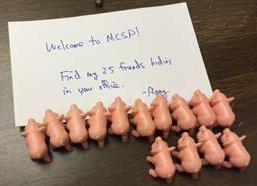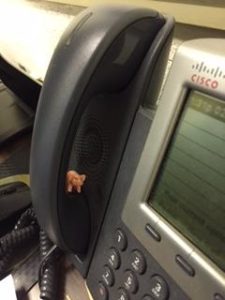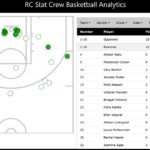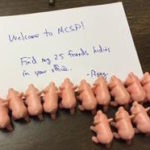Well, it’s tough to admit, but on Feb 21, 2017, I was pigged…or, rather, my office was pigged.
Why bring this up on a math blog post? Well, you may have heard about the game Pass the Pigs, which can be a very educational game in that it teaches people about probability. This game is very similar to Farkle; however, it involves rolling two rubber pigs instead of rolling dice.
Points are determined by the formation of the pigs once they’ve been rolled. For example, in the following configuration, the roller would win 10 points:
The pig on the left in the above picture is in the “razorback” position, and the pig on the right is in the “trotter” position. In the actual game Pass the Pigs, each pig has a dot on one side, and a certain formation of the rolled pigs (both on their sides, one dot up and one dot down) is called the “pig out” position, which results in a score of 0 for the roller’s turn.
The pigs that took over my office weren’t exactly Pass the Pigs pigs, since they were lacking dots, but they still have the same rolling behavior! Some of our Roanoke College math faculty have used these pigs in class to help students grasp ideas of probability. See, the issue is that the probability of rolling one configuration is not the same as rolling another configuration. It’s different from rolling dice. When you roll a die, the probability of getting a 3 is the same as the probability of getting a 5 (for a balanced die, at least). However, when you roll a pig, the probability of the pig ending up on its back is 22.4%, whereas the probability of the pig ending up on its feet is 8.8%. How do we know this? Well, one way to get a rough idea is to roll a pig 1000 times and record the rolled formations.
But, what’s the probability of rolling two pigs and having one end up on its feet and the other on its back? Well, the multiplication rule of probability says that if the two events (i.e. the two pigs) are independent, then the probability of both occurring is the product of the probabilities of the two events. What does independent mean here? Basically it means that the probability of event A (pig 1 ending up on its feet) is not affected by the probability of event B (pig 2 ending up on its back). These events are independent, and hence the probability of rolling two pigs and having one end up “razorback” and the other “trotter” is (.224) * (.088) = .01971 = 1.97%.
Note that the probability of rolling a “pig out” is P(on side, dot up)*P(on side, dot down) = (.302)*(.349) = .1054 = 10.54%. This is a huge difference!
If you’re interested in learning more, here’s a great article, written by Michael Gorman:
Analytics, Pedagogy, and the Pass the Pigs Game
But, just remember to Beware the Pigs!
Source: Michael F. Gorman, (2012) Analytics, Pedagogy and the Pass the Pigs Game. INFORMS Transactions on Education 13(1):57-64. http://dx.doi.org/10.1287/ited.1120.0088.














